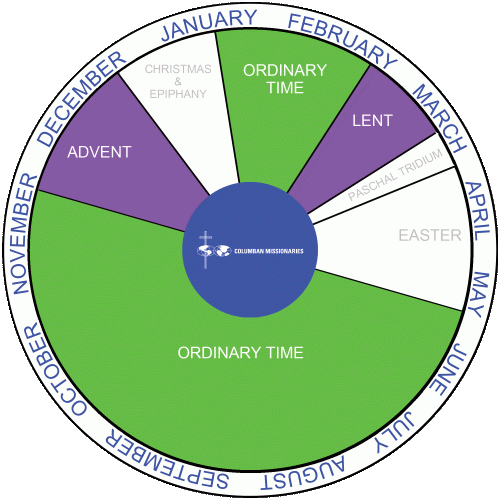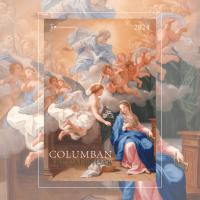
Liturgical calendar
The Catholic Church sets aside certain days and seasons of each year to recall and celebrate various events in the life of Christ. In its Roman Rite the liturgical year begins with Advent, the time of preparation for both the celebration of Jesus' birth, and his expected second coming at the end of time. This season lasts until 24 December (Christmas Eve). Christmastide follows, beginning with First Vespers of Christmas on the evening of 24 December and ending with the Feast of the Baptism of the Lord.
Advent
Advent (from the Latin word adventus, which means "arrival" or "coming") is the first season of the liturgical year, it is a time of preparation for the Solemnities of Christmas, in which the First Coming of the Son of God to humanity is remembered, and likewise a time when, by remembrance of this, minds and hearts are led to look forward to Christ's Second Coming at the end of time.
It begins four Sundays before Christmas, the Sunday falling on or nearest to 30 November, and ends on Christmas Eve. Traditionally observed as a "fast", it focuses on preparation for the coming of Christ, not only the coming of the Christ-child at Christmas, but also, in the first weeks, on the eschatological (final coming) of Christ, making Advent "a period for devout and joyful expectation".
This season is often marked by the Advent Wreath, a garland of evergreens with four candles. Although the main symbolism of the advent wreath is simply marking the progression of time, many churches attach themes to each candle, most often 'hope', 'faith', 'joy', and 'love'.
Liturgical colour: violet or purple; blue in some traditions.
Christmas
The Christmas season immediately follows Advent. The traditional Twelve Days of Christmas begins with Christmas Eve on the evening of December 24 and continues until the feast of Epiphany. The actual Christmas season continues until the Feast of the Baptism of Christ, which in the present form of the Roman Rite is celebrated on the Sunday after 6 January, or the following Monday if that Sunday is Epiphany.
Liturgical colour: white.
Lent
Lent is a major penitential season of preparation for Easter.
The forty days of Lent run from Ash Wednesday up to but excluding the Mass of the Lord's Supper. From the beginning of Lent until the Paschal Vigil, the Alleluia is not said.
On Ash Wednesday, the beginning of Lent, which is observed everywhere as a fast day, ashes are distributed.
The Sundays of this time of year are called the First, Second, Third, Fourth and Fifth Sundays of Lent. The Sixth Sunday, on which Holy Week begins, is called, 'Palm Sunday of the Passion of the Lord'.
Holy Week - the week before Easter
The colour rose may be used, where it is the practice, on Laetare Sunday (4th Sunday of Lent). On Palm Sunday the colour since 1970 is red, by earlier rules violet or purple, with red being used after 1955 for the blessing of the palms.
Liturgical colour: violet or purple.
Paschal Triduum
The Paschal Triduum consists of Good Friday, Holy Saturday and Easter Sunday.
Each of these days begins liturgically not with the morning but with the preceding evening.
The Paschal Triduum of the Passion and Resurrection of the Lord, begins with the evening Mass of the Lord's Supper, has its centre in the Easter Vigil, and closes with Vespers (Evening Prayer) of the Sunday of the Resurrection.
The Easter Vigil, in the holy night when the Lord rose again, is considered the 'Mother of all Holy Vigils', in which the Church, keeping watch, awaits the Resurrection of Christ and celebrates it in the Sacraments. Therefore, the entire celebration of this sacred Vigil must take place at night, so that it begins after nightfall and ends before the dawn on the Sunday.
Easter season
Easter is the celebration of Jesus' resurrection. The date of Easter varies from year to year, according to a lunar-calendar dating system in the Roman Rite, the Easter season extends from the Easter Vigil through to Pentecost Sunday.
Liturgical colour: white, but red on the feast of Pentecost.
Ordinary Time
"Ordinary" comes from the same root as our word "ordinal", and in this sense means "the counted weeks". In the Roman Catholic Church and in some Protestant traditions, these are the common weeks which do not belong to a proper season. In Latin, these seasons are called the weeks per annum, or "through the year".
Ordinary Time begins on the Monday which follows the Sunday occurring after 6 January and extends up to and including the Tuesday before the beginning of Lent; it begins again on the Monday after Pentecost Sunday and ends before First Vespers (Evening Prayer 1) of the First Sunday of Advent.
Liturgical colour: green.
ORDER YOUR COPY OF THE 2016 COLUMBAN ART CALENDAR ONLINE NOW
or

